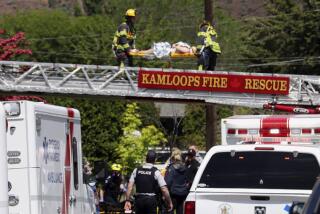Human-powered flight stays airborne
- Share via
In what may well be one of the last aviation firsts, a University of Toronto graduate student has fulfilled an ancient dream that dates back at least to the Greek legend of Daedalus and Icarus — human-powered flight.
FOR THE RECORD:
Human-powered flight: An article in the Sept. 25 Section A said that a Canadian graduate student had succeeded in making the first human-powered flight. The article should have said that it was the first human-powered flight achieved by flapping wings. —
In an ungainly wing-flapping craft, or ornithopter, built by students at the university, Todd Reichert made history last month by sustaining both altitude and airspeed for 19.3 seconds, traveling a little more than 145 yards at an average speed of about 16 mph.
The flight, conducted at sunrise Aug. 2 at the Great Lakes Gliding Club in Tottenham, Ontario, was witnessed by a vice president of the Federation Aeronautique Internationale, which certifies aviation records. Reichert’s time and distance are expected to be recognized as world records for human-powered flight at a meeting next month of the federation.
The craft — called the Snowbird because some of the first ground tests were conducted last winter on a snow-covered runway — has a wingspan of 105 feet. That’s nearly as long as the wingspan of a modern-day Boeing 737 jetliner. But because it is constructed of balsa wood, foam and carbon fiber, it weighs only 94 pounds — less then all the pillows normally carried by a commercial 737, Reichert said.
The ornithopter is powered by the pilot pumping his legs up and down, as if working out on a StairMaster. That causes the ends of the wings to flex like those of a giant pterosaur.
The Snowbird, which cost more than $200,000, was designed and built under the guidance of emeritus aerospace engineering professor James D. DeLaurier, who has been studying ornithopters for most of his career. More than 30 students and two civilian volunteers participated in its construction.
The inaugural flight was made at 6:45 a.m., a time when there were virtually no winds to interfere. The students completed final assembly of the craft onsite because, Reichert said, they had no barn or other building big enough to hold it.
Initially, the craft was towed behind a car, but when the tow-line was released, it was powered solely by Reichert’s legs. The fact that he was able to maintain airspeed and altitude indicated that he was actually powering the craft rather than simply gliding.
Reichert said he underwent months of training to build up leg strength. He also shed 18 pounds to minimize the effort required.
The aircraft is not a practical method of transport, Reichert said in a statement released this week. Rather, it is “meant to act as an inspiration to others to use the strength of their body and the creativity of their minds to follow their dreams.”
The students involved also used it as a way to learn about how to build lightweight structures.
More to Read
Sign up for The Wild
We’ll help you find the best places to hike, bike and run, as well as the perfect silent spots for meditation and yoga.
You may occasionally receive promotional content from the Los Angeles Times.




